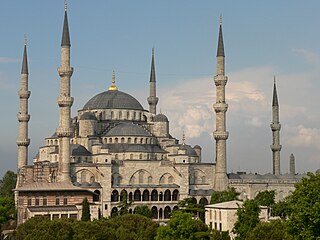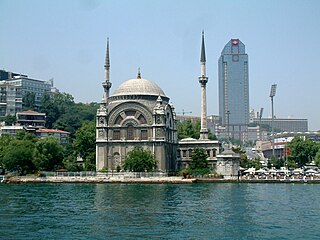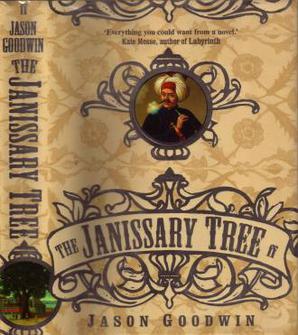
Osman II, also known as Osman the Young, was the sultan of the Ottoman Empire from 26 February 1618 until his regicide on 20 May 1622.

Turkish cuisine is the cuisine of Turkey and the Turkish diaspora. Although the cuisine took its current rich form after numerous cultural interactions throughout centuries, it should not be confused with other cuisines such as Ottoman cuisine or Seljuk cuisine. Turkish cuisine with traditional Turkic elements such as yogurt, ayran, kaymak, exerts and gains influences to and from Mediterranean, Balkan, Middle Eastern, Central Asian and Eastern European cuisines.

The fall of Constantinople, also known as the conquest of Constantinople, was the capture of the capital of the Byzantine Empire by the Ottoman Empire. The city was captured on 29 May 1453 as part of the culmination of a 53-day siege which had begun on 6 April.

A janissary was a member of the elite infantry units that formed the Ottoman Sultan's household troops. They were the first modern standing army, and perhaps the first infantry force in the world to be equipped with firearms; adopted during the reign of Murad II. The corps was established either under Sultans Orhan or Murad I, and dismantled by Mahmud II in 1826.

The Topkapı Palace, or the Seraglio, is a large museum and library in the east of the Fatih district of Istanbul in Turkey. From the 1460s to the completion of Dolmabahçe Palace in 1856, it served as the administrative center of the Ottoman Empire, and was the main residence of its sultans.

A matchlock or firelock is a historical type of firearm wherein the gunpowder is ignited by a burning piece of flammable cord or twine that is in contact with the gunpowder through a mechanism that the musketeer activates by pulling a lever or trigger with their finger. This firing mechanism was an improvement over the hand cannon, which lacked a trigger and required the musketeer or an assistant to apply a match directly to the gunpowder by hand. The matchlock mechanism allowed the musketeer to apply the match himself without losing his concentration.

Devshirme was the Ottoman practice of forcibly recruiting soldiers and bureaucrats from among the children of their Balkan Christian subjects and raising them in the religion of Islam. Those coming from the Balkans came primarily from noble Balkan families and rayah (poor) classes. It is first mentioned in written records in 1438, but probably started earlier. It created a faction of soldiers and officials loyal to the Sultan. It counterbalanced the Turkish nobility, who sometimes opposed the Sultan. The system produced a considerable number of grand viziers from the 1400s to the 1600s. This was the second most powerful position in the Ottoman Empire, after the sultan. Initially, the grand viziers were exclusively of Turk origin, but after there were troubles between Sultan Mehmed II and the Turkish grand vizier Çandarlı Halil Pasha the Younger, who was the first grand vizier to be executed, there was a rise of slave administrators (devshirme). They were much easier for the sultans to control, compared to free administrators of Turkish aristocratic extraction. The devshirme also produced many of the Ottoman Empire's provincial governors, military commanders, and divans during the 1400s–1600s period. Sometimes, the devshirme recruits were castrated and became eunuchs. Although often destined for the harem, many eunuchs of devshirme origin went on to hold important positions in the military and the government, such as grand viziers Hadım Ali Pasha, Sinan Borovinić, and Hadım Hasan Pasha.

The Military of the Ottoman Empire was the armed forces of the Ottoman Empire.

Mimar Sinan also known as Koca Mi'mâr Sinân Âğâ, was the chief Ottoman architect, engineer and mathematician for sultans Suleiman the Magnificent, Selim II and Murad III. He was responsible for the construction of more than 300 major structures, including the Selimiye Mosque in Edirne, the Kanuni Sultan Suleiman Bridge in Büyükçekmece, and the Mehmed Paša Sokolović Bridge in Višegrad, as well as other more modest projects such as madrasa's, külliyes, and bridges. His apprentices would later design the Sultan Ahmed Mosque in Istanbul and the Stari Most bridge in Mostar.

Ottoman architecture is an architectural style or tradition that developed under the Ottoman Empire over a long period, undergoing some significant changes during its history. It first emerged in northwestern Anatolia in the late 13th century and developed from earlier Seljuk Turkish architecture, with influences from Byzantine and Iranian architecture along with other architectural traditions in the Middle East. Early Ottoman architecture experimented with multiple building types over the course of the 13th to 15th centuries, progressively evolving into the classical Ottoman style of the 16th and 17th centuries. This style was a mixture of native Turkish tradition and influences from the Hagia Sophia, resulting in monumental mosque buildings focused around a high central dome with a varying number of semi-domes. The most important architect of the classical period is Mimar Sinan, whose major works include the Şehzade Mosque, Süleymaniye Mosque, and Selimiye Mosque. The second half of the 16th century also saw the apogee of certain decorative arts, most notably in the use of Iznik tiles.

The Islamic Sacred Relics, also known as the Holy Relics, known collectively as the Sacred Trust, consist of religious relics sent to the Ottoman Sultans between the 16th century to the late 19th century.

Bezmiâlem Sultan, called also Bazimialam Sultan, was a consort of Sultan Mahmud II, and Valide sultan to their son, Sultan Abdulmejid I of the Ottoman Empire.

The Eyüp Sultan Mosque is in the Eyüp district of Istanbul, outside the city walls and near the Golden Horn. The mosque complex includes a mausoleum marking the spot where Ebu Eyüp el-Ansari, the standard-bearer and companion of the Islamic prophet Muhammad, is said to have been buried. On a much older site, the present building dates from the beginning of the 19th century.

Kösem Sultan, also known as Mahpeyker Sultan, was Haseki Sultan of the Ottoman Empire as the chief consort of the Ottoman Sultan Ahmed I, Valide Sultan as the mother of sultans Murad IV and Ibrahim, and Büyük Valide Sultan as the grandmother of Sultan Mehmed IV. She became one of the most powerful and influential women in Ottoman history as well as a central figure during the period known as the Sultanate of Women.

Ottoman cuisine is the cuisine of the Ottoman Empire and its continuation in the cuisines of Turkey, the Balkans, Caucasus, Middle East and Northern Africa.

The Janissary Tree is a historical mystery novel set in Istanbul in 1836, written by Jason Goodwin. It is the first in the Yashim the Detective series, followed by The Snake Stone, The Bellini Card, An Evil Eye and The Baklava Club. The series features Yashim, an eunuch detective, who is resourceful and learned in both the Ottoman culture and that of the West, enjoys the trust of the Sultan and high officials, and prefers to live in a rather bohemian lodging outside the palace complex. The novel deals with the fictional aftermath of the Auspicious Event, the disbanding of the Janissaries, once elite troops of the Ottoman Empire.
Eunuchs have appeared in many films, works of literature, and in popular culture.

The gunpowder empires, or Islamic gunpowder empires, is a collective term coined by Marshall G. S. Hodgson and William H. McNeill at the University of Chicago, referring to three early modern Muslim empires: the Ottoman Empire, Safavid Empire and the Mughal Empire, in the period they flourished from mid-16th to the early 18th century. These three empires were among the most stable empires of the early modern period, leading to commercial expansion, and patronage of culture, while their political and legal institutions were consolidated with an increasing degree of centralization. They stretched from Central Europe and North Africa in the west to Bengal and Arakan in the east. Hodgson's colleague William H. McNeill expanded on the history of gunpowder use across multiple civilizations including East Asian, South Asian and European powers in his "The Age of Gunpowder Empires". Vast amounts of territory were conquered by the gunpowder empires with the use and development of the newly invented firearms, especially cannon and small arms, in the course of imperial expansion. Like in Europe, the introduction of gunpowder weapons prompted changes such as the rise of centralized monarchical states.

Belgrad Forest is a mixed deciduous forest lying adjacent to Istanbul, Turkey. It is named after the village next to the forest, settled by thousands of Serbs who were deported to the capital Constantinople from the city of Belgrade in 1521, when it fell to the Ottomans. Geographically, the forest is located at the easternmost point of the Thracian Peninsula. Forest terrain is divided between Sarıyer and Eyüp districts. Several historical reservoirs lie within the forest.

Classical Ottoman architecture is a period in Ottoman architecture generally including the 16th and 17th centuries. The period is most strongly associated with the works of Mimar Sinan, who was Chief Court Architect under three sultans between 1538 and 1588. The start of the period also coincided with the long reign of Suleiman the Magnificent, which is recognized as the apogee of Ottoman political and cultural development, with extensive patronage in art and architecture by the sultan, his family, and his high-ranking officials.




















